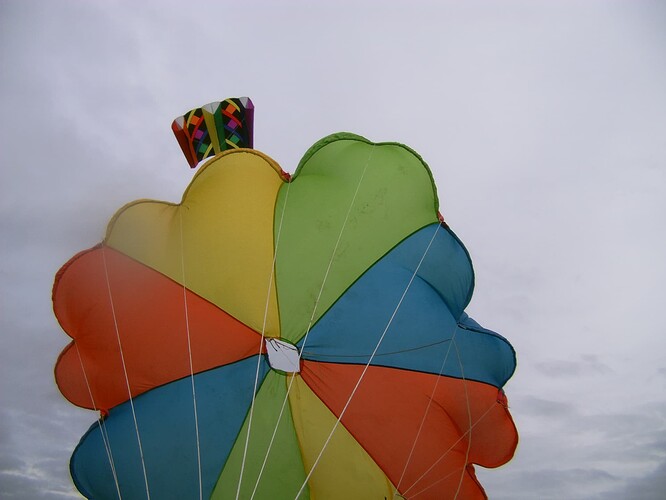Parachutes were tested as AWES and were discussed.
It appears that the aerostat provides all of the lift for both parachutes. And whatever the first parachute is open or shut does not significantly change the elevation angle of the two parachutes while that of the aerostat is very high.
Under these conditions, to increase the number of parachutes or their total area as well as stability, it would be necessary to increase the dimensions of the supporting element (aerostat or kite lifter), which would become difficult from a certain threshold.
I myself tried to experiment with an admittedly rudimentary parachute, and with a very good lifter kite (a sled) of 1.7 m², today, after the previous experiment with a 0.2 m² lifter kite for the same parachute:
Parachute of projected area of about 5 m², with a lifter kite of 1.7 m². In spite of the high area of the lifter kite compared to that of the parachute, this one flew at a low angle of elevation (about 10 to 20 degrees) compared to that of the lifter kite (50 degrees). Moreover oscillations occurred from top to bottom. The tether of the lifter kite was attached to the periphery of the central hole.
A photo:
In contrast, a parasail provides its own lift thanks to vents and vent slits, and a little ballast at the bottom plus the user’s weight.
With equal traction, parasails seem to be of a price comparable to that of power kites which have a significantly smaller surface area.
1 700,00 $US -2 000,00 $US
Min. Order: 2 Pièces
Compared to:
Used in yoyo mode, a simple power-depower module (which also plays the role of ballast) should be studied.
It would be interesting to know to what dimensions a parasail could scale. Already the basic products are of respectable dimensions (diameter 10 to 12 m) but insufficient for AWES use.


